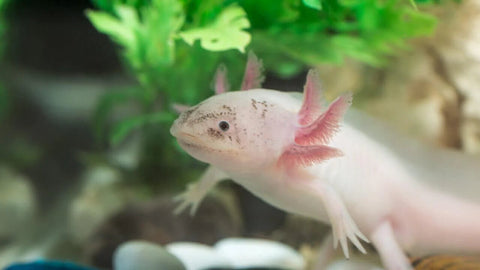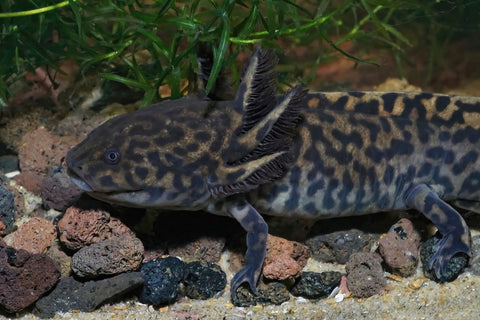Axolotls are fascinating creatures, not only because of their unique appearance, but also because of their special care needs. For all aquarists thinking about keeping an axolotl, it is important to learn about the basics of keeping and caring for them. In this article, we will cover the most important aspects of axolotl care so that you can successfully care for your new friend in the long term.
What is an axolotl?
Axolotls, also known as Mexican salamanders (Ambystoma mexicanum), are neotenic amphibians found in the waters of Mexico. They are famous for their incredible ability to regenerate body parts, making them an exciting subject for scientists to study. Their striking appearance, with the characteristic gills on the sides of their head, makes them a popular choice for aquarium enthusiasts.
The ideal home for your axolotl
The aquarium
Axolotl need enough space to move around and thrive. An aquarium with a volume of at least 100 litres is recommended for one Axolotl. If you have more than one, the aquarium should be correspondingly larger. Make sure that the aquarium has a sturdy lid, because Axolotl are strong swimmers and can jump.
The water temperature
The ideal water temperature for axolotls is between 16 and 20 degrees Celsius. They are very sensitive to temperature changes, so you should make sure that the water temperature remains constant. A cooling system may be necessary, especially during the hot summer months.
The water quality
Clean and well-filtered water is crucial for the health of your axolotl. Use a high-quality external filter and change some of the water regularly to keep nitrite, nitrate and ammonia at a minimum level. Also, get a water test kit to check the water values regularly.
The right nutrition
What do axolotls eat?
Axolotls are carnivorous and require a protein-rich diet to stay healthy and active. You can offer them special food pellets that are suitable for their needs. In addition, you can also offer live food such as earthworms or mosquito larvae. Be sure to feed the food in appropriate portions to avoid overfeeding and water pollution.
How often to feed your axolotl?
Albino and wild-coloured axolotls should be fed once a day, while adult axolotls can be fed every two to three days. Always monitor your animal's behaviour – if it shows signs of being overweight, adjust the amount of food accordingly.
Health monitoring
Typical diseases and how to prevent them
Axolotls are relatively hardy animals, but they can be susceptible to certain diseases, especially in unclean environments. The most common diseases include:
- Dermatitis: a skin disease caused by poor water conditions.
- Putrefaction of the gills: this can be due to overcrowding or inadequate water quality.
- Parasites: Watch for signs of discomfort and keep your animal away from other animals to prevent infection.
Regular checks and good hygiene are essential to ensure the health of your axolotl.
First aid for axolotls
In case of injury or illness, you should take immediate action. Start by checking the water quality and improving it if necessary. For serious injuries or signs of illness, it is advisable to consult a veterinarian specialising in exotic animals.
Sociable aquaristics – who can axolotls live with?
Axolotls are best kept alone, as they are territorial and tend to injure or eat other animals. If you plan to keep several axolotls, you should make sure that the aquarium is large enough to provide each animal with sufficient swimming space.
Setting up the aquarium
The substrate
The substrate for an axolotl aquarium should not have sharp edges to avoid injuries. River sand or fine gravel are good options as they allow the axolotl to dig without risking injury.
Hiding places
Axolotl feel safer when they have places to hide. Add suitable caves, pieces of driftwood or aquarium plants where they can hide. This reduces stress and promotes a healthy environment.
The importance of light and lighting
Although axolotl do not require intense lighting, soft lighting is beneficial to support the plants in the aquarium and promote the well-being of the animals. Make sure that the lighting is not too strong to avoid stressing the animals.
Behaviour and interaction with axolotls
Axolotls are fascinating animals that display a range of behaviours. They are curious and like to explore their environment. When interacting with them, it is important to handle them gently and to pay attention to their stress levels. Too much handling can be harmful to them.
Reproduction of axolotls
Axolotls can be bred in suitable conditions. However, this requires extensive knowledge and experience. If you are interested in breeding, you should do a lot of research and make sure that you have the necessary equipment and knowledge to take care of the eggs and larvae.
Paying attention to the long term
Caring for axolotls is a long-term commitment. They can live up to 15 years in captivity, which means you have to act responsibly throughout the entire lifespan of your axolotl. Actively engage with their care, their environment, the aquarium, and their well-being.
Become an axolotl expert
With this basic information, you are well equipped to care for your axolotl in a species-appropriate way. Remember that knowledge is the key to successful husbandry. Keep learning about new insights and experiences in axolotl care. Your hungry little friend will thank you by staying happy and healthy.




Comments (0)
There are no comments for this article. Be the first one to leave a message!